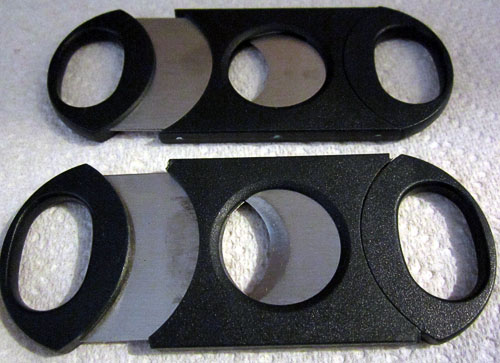For several years, I have cut the tuck (foot) of my freshly rolled cigars with my kulu (surrogate chaveta). This works fairly well. The most common problem that this causes is that occasionally, a tiny bit of wrapper is split on either side of the foot, as a result of the crushing effect of the kulu blade. The kulu cuts from only a single direction, toward the underlying cutting board, and with a convex blade curvature that is opposite of the curve of the cigar foot.
Commercial tuck cutters incorporate two concave blades to minimize the likelihood of splitting the foot. They also usually provide an adjustable length gauge for replicating the length of multiple cigars--if you happen to be a factory. Some of them are designed to mount onto the upper margin of a cutting board. They can be stunningly expensive (over $200 new), though used ones can be found for much less. If you buy a used one, expect to do some serious sharpening.
There are some fancy double-bladed guillotine cigar cutters on the market (intended for opening the head) that often cost $30 to $60 or more. These would accomplish a clean tuck cut, though they do lack the length gauge.
A couple of weeks ago, I noticed that JR Cigars (www.jrcigars.com) offered a basic, double-bladed guillotine cigar cutter for $3. I purchased two. The blades are stainless steel.
http://www.jrcigars.com/jr/index.cf...12/DOUBLE-BLADED-GUILLOTINE-CUTTER-GREEN.html

These are both the same size, despite the camera angle. The upper one is unmodified.
This cheapo cutter accommodates up to about 60 ring (1" in diameter), and easily makes a perfect tuck cut--much nicer than the kulu can make. The stainless edges should last a while.
But it has a serious problem. The two blades, which move with the finger holes, close firmly against the center plastic piece. Apparently for aesthetic reasons, the designer of this device made the concave arcs of the center piece end in sharp points--looks pretty when closed. No matter how much I paid attention to the positioning of my extra fingers (the ones not inserted into the finger holes), I repeatedly pinched a fingertip when the blades closed. I have a blood blister to prove it.
By using a cutting disk on a Dremmel, I removed all four of those nasty points. Problem solved. Notice the notches in the right closure on the modified cutter (the lower one in the photo).
At only $3 each, plus a quick mod with a Dremmel or small file, these inexpensive cutters can be a useful addition to your cigar-making arsenal.
Bob
Commercial tuck cutters incorporate two concave blades to minimize the likelihood of splitting the foot. They also usually provide an adjustable length gauge for replicating the length of multiple cigars--if you happen to be a factory. Some of them are designed to mount onto the upper margin of a cutting board. They can be stunningly expensive (over $200 new), though used ones can be found for much less. If you buy a used one, expect to do some serious sharpening.
There are some fancy double-bladed guillotine cigar cutters on the market (intended for opening the head) that often cost $30 to $60 or more. These would accomplish a clean tuck cut, though they do lack the length gauge.
A couple of weeks ago, I noticed that JR Cigars (www.jrcigars.com) offered a basic, double-bladed guillotine cigar cutter for $3. I purchased two. The blades are stainless steel.
http://www.jrcigars.com/jr/index.cf...12/DOUBLE-BLADED-GUILLOTINE-CUTTER-GREEN.html

These are both the same size, despite the camera angle. The upper one is unmodified.
This cheapo cutter accommodates up to about 60 ring (1" in diameter), and easily makes a perfect tuck cut--much nicer than the kulu can make. The stainless edges should last a while.
But it has a serious problem. The two blades, which move with the finger holes, close firmly against the center plastic piece. Apparently for aesthetic reasons, the designer of this device made the concave arcs of the center piece end in sharp points--looks pretty when closed. No matter how much I paid attention to the positioning of my extra fingers (the ones not inserted into the finger holes), I repeatedly pinched a fingertip when the blades closed. I have a blood blister to prove it.
By using a cutting disk on a Dremmel, I removed all four of those nasty points. Problem solved. Notice the notches in the right closure on the modified cutter (the lower one in the photo).
At only $3 each, plus a quick mod with a Dremmel or small file, these inexpensive cutters can be a useful addition to your cigar-making arsenal.
Bob



